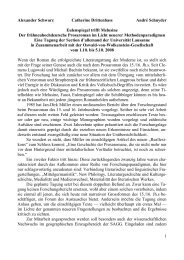Medieval Autograph Manuscripts - Mediaevum
Medieval Autograph Manuscripts - Mediaevum
Medieval Autograph Manuscripts - Mediaevum
You also want an ePaper? Increase the reach of your titles
YUMPU automatically turns print PDFs into web optimized ePapers that Google loves.
<strong>Medieval</strong> <strong>Autograph</strong> <strong>Manuscripts</strong><br />
XVIIth Colloquium of the Comité international de paléographie latine<br />
PLACE<br />
Ljubljana (Slovenia), Narodna Galerija (National Gallery)<br />
DATES<br />
07 September 2010 -- 10 September 2010<br />
SUMMARY<br />
Through the study of a representative panel of individual cases, the Conference will address<br />
the wide range of problems that arise from autograph manuscripts (i.e. those whose author<br />
and copyist is one single person) in the fields of palaeography, codicology, the diffusion,<br />
transmission and scholarly edition of the texts.<br />
THEMATIC GUIDELINES<br />
The autograph manuscripts of certain important medieval authors are well-known and have<br />
long been studied (Lupus de Ferrières, Thomas Aquinas, Petrarch). Their manuscripts not<br />
only constitute the basis of modern editions of their works, but are also important sources for<br />
the history of writing and for what they tell us about the different working methods of such<br />
authors.<br />
Twentieth-century palaeographical research and the cataloguing of manuscripts have both<br />
brought to light a number of 'new' autograph manuscripts. With few exceptions, however,<br />
only the autograph manuscripts of well-known authors have been the object of more intensive<br />
palaeographical or codicological study. Most autograph manuscripts have not yet received the<br />
attention that they deserve.<br />
The following themes will be addressed by the speakers<br />
1. Different states of autograph manuscript: first draft - unfinished manuscript - first version<br />
of a text - dedication copies.<br />
2. Collaboration between authors, secretaries, and copyists: manuscripts partially autograph<br />
- author - supervised manuscripts - texts annotated and corrected by authors<br />
themselves - authors as copyists of their own works - copies of autograph manuscripts.<br />
3. Palaeographical aspects: an author's handwriting in relation to the handwriting of his<br />
period - individual ways of abbreviating words - tachygraphic notes.<br />
4. Codicological aspects: those features which distinguish between a manuscript for personal<br />
use and one intended for public consumption (material support, make - up of<br />
quires, mise en page, etc).<br />
5. <strong>Autograph</strong> manuscripts of different kinds of text: Carolingian - legal - medical - history<br />
-<br />
sermons - university manuscripts - ecumenical councils - humanist - translations and<br />
compilations of texts in the vernacular - letter collections - autograph documents<br />
(charters, letters missives, etc).<br />
6. Particular or exceptional cases: autograph manuscripts 'par personne interposée' - multiple<br />
autograph manuscripts of the same work - manuscripts illuminated by the author -<br />
princely and papal autograph manuscripts - autograph manuscripts attributed to saints<br />
- anonymous autograph manuscripts.
7. The status of autograph manuscripts in the Middle Ages - the value attributed to autograph<br />
manuscripts in the Middle Ages - the transition of the medieval autograph<br />
manuscript to the ‘modern' autograph.<br />
PROGRAMME<br />
• E. Overgaauw, Comment reconnaître un autographe du Moyen Age?<br />
• T. De Robertis, Una mano tante scritture. Problemi di metodo dell'identificazione degli<br />
autografi<br />
• P. Breatnach, Continuity and change, developments in the script and style of some<br />
early Irish autograph manuscripts<br />
• D. Ganz, The Copenhagen 'Solinus' and the problems of Carolingian autographs<br />
• H. Eisenhut, Ekkehart IV of St Gall and the glossator of St Gall 393<br />
• D. Frioli, <strong>Manuscripts</strong> of Gerhoch of Reichersberg<br />
• G. Bernhard, Gottfried von Viterbo und sein Werk 'Liber universalis'<br />
• P. Carmassi, Redazione e scrittura di un nuovo modello di lezionario nella diocesi di<br />
Halberstadt (s. XII)<br />
• Z. Hledíková, Petrus Zittaviensis<br />
• M. Roland, Ulrich of Lilienfeld and the 'original' manuscript of his 'Concordantiae Caritatis'<br />
• R. Beadle, Palaeography and the Pastons<br />
• S. Horobin, Osbern Bokenham : author and scribe?<br />
• M. Aussems, 'Escript à Paris par moi, Cristine de Pizan'?<br />
• J. Hamesse, Matthieu d'Acquasparta et ses autographes<br />
• A. Postec, Processus et formes d'écriture d'un maître universitaire : Matthieu d'Aquasparta<br />
• F. Gimeno Blay, <strong>Autograph</strong>es du roi Pierre le Cérémonieux<br />
• M. Rodríguez Díaz, Manoscritos autógrafos en la producción castellana del siglo XV<br />
• P. Gumbert, <strong>Manuscripts</strong> of historians<br />
• G. Murano, <strong>Autograph</strong>s of learned Italian men (s. XIII-s. XVI)<br />
• M. Signorini, Petrarch's 'tracce' : dates, form, features<br />
• L. Nuvoloni, Men of letters in Renaissance Italy, Bernardo Bembo and Bartolomeo<br />
San Vito<br />
• Guðvarður Gunnlaugsson, Einar Hafliðason - an Icelandic author, s. XIV<br />
• E. Madas, Deux manuscrits autographes en langue hongroise de la fin du Moyen Âge.<br />
De l'impurum à la copie d'auteur.<br />
CONTACT<br />
Dr Pamela R. ROBINSON<br />
Institute of English Studies<br />
School of Advanced Study, University of London<br />
Senate House, Malet Street, London WC1E 7HU<br />
Fax: [44] 0207 - 862 8672<br />
Pamela.Robinson@sas.ac.uk<br />
WEBSITE<br />
Comité international de paléographie latine<br />
http://www.palaeographia.org/cipl/ljubljana/<br />
2







